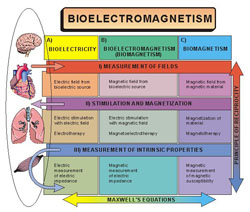Bioelectromagnetism
Principles and Applications of Bioelectric and Biomagnetic Fields, OXFORD UNIVERSITY PRESS – 1995
Bioelectric phenomena have been a part of medicine throughout its history. The first written document on bioelectric events is an ancient Egyptian hieroglyph of 4000 B.C. describing the electric sheatfish. Bioelectromagnetism is, of course, based strongly on the general theory of electromagnetism. In fact, until the middle of the nineteenth century the history of electromagnetism was also the history of bioelectromagnetism. From the viewpoint of modern science, bioelectric phenomena have had scientific value for the past 200 years. Many of the fundamental contributions to the theory of bioelectromagnetism were made in the nineteenth century. Only in the past 100 years has bioelectromagnetism had real diagnostic or therapeutic value. As we know, this is actually the case for most of medicine as well.
During the past few decades, the advances in the theory and technology of modern electronics have led to improvements in medical diagnostic and therapeutic methods and, as a result, bioelectric and biomagnetic phenomena have become increasingly important. Today it is impossible to imagine a hospital without electrocardiography and electroencephalography. The development of microelectronics has made such equipment portable and has increased their diagnostic power. Implantable cardiac pacemakers have allowed millions of people to return to normal life. The development of superconducting technology has made it possible to detect the weak biomagnetic fields induced by bioelectric currents. The latest advances in the measurement of electric currents flowing through a single ion channel of the cell membrane with the patch clamp have opened up completely new applications for bioelectromagnetism. With the patch clamp, bioelectromagnetism can also be applied to molecular biology, for instance, in developing new pharmaceuticals. These examples illustrate that bioelectromagnetism is a vital part of our everyday life.
This book first provides a short introduction to the anatomy and physiology of excitable tissues, and then introduces the theory and associated equations of bioelectric and biomagnetic phenomena; this theory underlies all practical methods. The book then describes current measurement methods and research results and provides an account of their historical development.
The chapters dealing with the anatomy and physiology of various organs are necessarily elementary as comprehensive texts are available in these disciplines. Nevertheless, we wanted to include introductory descriptions of the anatomy and physiology of neural and cardiac tissues in particular so that the readers would have a review of the structures and functions upon which electrophysiological models are based. We have also introduced readers to the relevant vocabulary and to important general references.
 The theory of bioelectromagnetism deals mainly with electrophysiological models of bioelectric generators, excitability of tissues, and the behavior of bioelectric and biomagnetic fields in and around the volume conductors formed by the body. Because of the nature of the bioelectric sources and the volume conductors, the theory and the analytic methods of bioelectromagnetism are very different from those of general electromagnetism. The theoretical methods are presented as a logical structure. As part of… TOVÁBB (pdf letöltés)
The theory of bioelectromagnetism deals mainly with electrophysiological models of bioelectric generators, excitability of tissues, and the behavior of bioelectric and biomagnetic fields in and around the volume conductors formed by the body. Because of the nature of the bioelectric sources and the volume conductors, the theory and the analytic methods of bioelectromagnetism are very different from those of general electromagnetism. The theoretical methods are presented as a logical structure. As part of… TOVÁBB (pdf letöltés)
[download id=”7″]